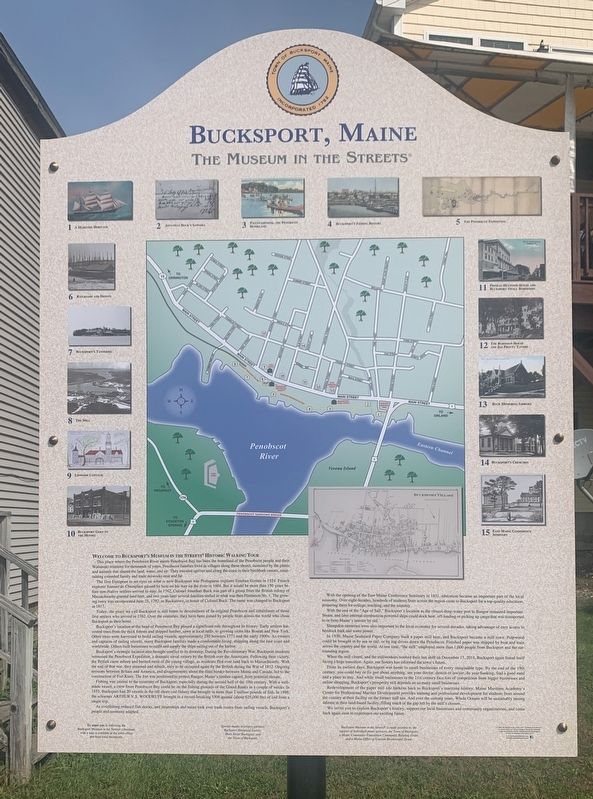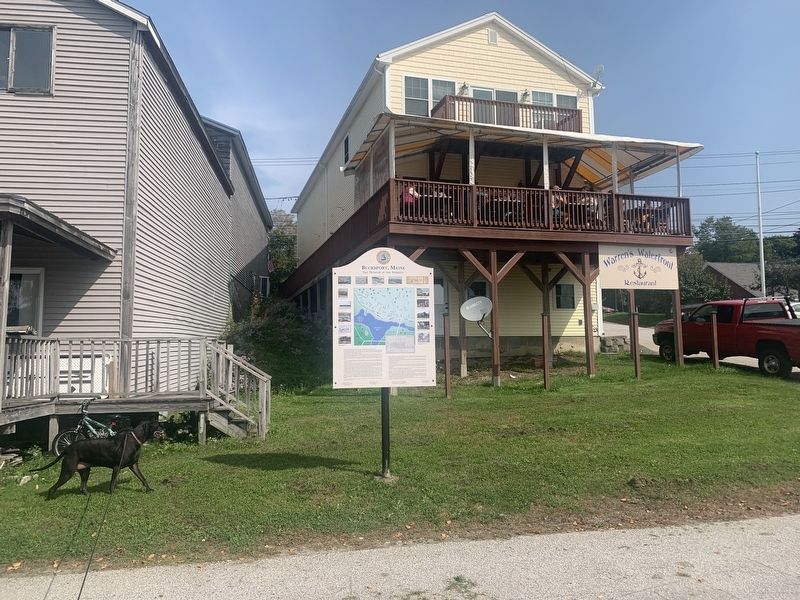Bucksport in Hancock County, Maine — The American Northeast (New England)
Bucksport, Maine
The Museum In The Streets
Welcome to Bucksport’s Museum in the Streets Historic Walking Tour
This place where the Penobscot River mets Penobscot Bay has been the homeland of the Penobscot people and their Wabanaki relations for thousands of years. Penobscot families families lived in villages along these shores, sustained by the plants and animals that shared the land, water and air. They traveled upriver and along the coast in their birchbark canoes, maintaining extended family and trade networks near and far.
The first European explorer to set eyes on what is now Bucksport was Portuguese explorer Estasban Gomes in 1524. French explorer Samuel de Champlain passed by here on his way up the river in 1604. But it would be more than 150 years before the first non-Native settlers arrived to stay. In 1762, Colonel Jonathan Buck was a group from the British colony of Massachusetts granted land here, and two years later several families settled in what was the Plantation No. 1. The growing town was incorporated June 25, 1792 as Buckstown, in honor of Colonel Buck. The name was later changed to Bucksport in 1817.
Today, the place we call Bucksport is still home to descendants of its original Penobscot and inhabitants of those first settlers who arrived in 1762. Over the centuries , they have been joned by people from across the world who chose Bucksport as their home.
Bucksport’s location at the head of Penobscot Bay played a significant role throughout its history. Early settlers harvested trees from thick forests and shipped lumber, sawn at local mills, to growing cities such as Boston and New York. Others were harvested to build sailing vessels, approximately 250 between 1771 and the early 1900s. As owners and captains of sailing vessels, many Bucksport families made a comfortable living, shipping along the east coast and worldwide. Others built businesses to outfit and supply the ships out of the harbor.
Bucksport’s strategic location also brought conflict to its doorstep. During the Revelionary War Bucksport residents witnessed the Penobscot Expedition, a dramatic naval victory by the British over the Americans. Following their victory, the British came ashore and burned most of the young village, as residents fled over land back to Massachusetts. With the end of that war, they returned and rebuilt, only to be occupied again by the British during the War of 1812. Ongoing tensions between Britain and America, and disagreements about the final border between Maine and Canada led to the construction of Fort Knox. The fort was positioned to protect Bangor, Maine’s lumber capital from potential threats.
Fishing was central to the economy of Bucksport, especially during the second half of the 19th century. With a well made vessel, screw from Penobscot Bay could be on the fishing grounds of the Grand Banks in a couple of weeks. In 1855, Bucksport had 20 vessels in the offshore cod fishery that brought in than 2 million pounds of fish. In 1898, the schooner ARTHUR V. S. WOODRUFF brought in a record-breaking 5500 quintal (about 625,000 lbs) of cod from a single trip.
As overfishing reduced fish stocks, and as steamboats and trains took over trade routes from sailing vessels, Buckport’s people and economy adapted.
With the opening of the East Maine Conference Seminary in 1851, education became an important part of the local economy. Over eight decades, hundreds of students from across the region came to Bucksport for a top-quality education, preparing them for college, teaching and the ministry.
With the end of the “Age of Sail,” Bucksport’s location as the closest deep-water port to Bangor remained important. Steam, and later internal combustion powered ships could dock here, off-loading or picking up cargo was transported to or from Maine’s interior by rail.
Sheepskin tanneries were also important to the local economy for several decades, taking advantage of easy access to hemlock bark and water power.
In 1930, Maine Seaboard Paper Company built a mill here, and Bucksport became a mill town. Pulpwood could be brought in by sea or rail or by log drives down the Penobscot. Finished paper was shipped by boat or rail across the country and the world. At one time, “the mill” employed more than 1,000 people from Bucksport and the surrounding region.
When the mill closed, and the millworkers worked their last shift on December 17, 2014, Bucksport again found itself facing a huge transition. Again, our history has informed the town's future.
From its earliest days, Bucksport was home to small businesses of every imaginable type. By the end of the 19th century, you could buy or fix just about anything, see your doctor, dentist or lawyer, do your banking, find a good meal and a place to stay. And while small businesses in the 21st century face lots of competition from bigger businesses and online shopping, Bucksport’s prosperity still depends on so many small businesses.
Redevelopment of the paper mill harkens back to Bucksport’s maritime history. Maine Marine Academy Center for Professional Mariner Development provides training and professional development for students around the country of their facility on the former mill site. And over the coming years, Whole Oceans will be sustainablly raising salmon in their land-based facility, filling much of the gap let by the mill's closure.
We invite you to explore Buckport’s history, support our local businesses and community organizations, and come back again soon to experience our exciting future.
Topics. This historical marker is listed in this topic list: Settlements & Settlers. A significant historical date for this entry is June 25, 1792.
Location. 44° 34.33′ N, 68° 47.808′ W. Marker is in Bucksport, Maine, in Hancock County. Marker can be reached from Main Street north of Mechanic Street. Located behind Warren’s Waterfront Restaurant on the Bucksport’s Public Landing. Touch for map. Marker is at or near this postal address: 96 Main Street, Bucksport ME 04416, United States of America. Touch for directions.
Other nearby markers. At least 8 other markers are within walking distance of this marker. The Penobscot Expedition (within shouting distance of this marker); The Town of Bucksport (about 400 feet away, measured in a direct line); Fort Knox (about 500 feet away); The Phineas Heywood House (about 600 feet away); Penobscot River (about 600 feet away); Rich in Heritage (approx. 0.2 miles away); Times of War (approx. 0.2 miles away); Of Ships and Men (approx. 0.2 miles away). Touch for a list and map of all markers in Bucksport.
More about this marker. The marker has 15 photos or illustrations of the various sites on the walking tour, as well as a large map showing the tour route.
Credits. This page was last revised on October 14, 2023. It was originally submitted on October 4, 2023, by Steve Stoessel of Niskayuna, New York. This page has been viewed 57 times since then and 18 times this year. Photos: 1. submitted on October 4, 2023, by Steve Stoessel of Niskayuna, New York. 2. submitted on October 10, 2023, by Steve Stoessel of Niskayuna, New York. • Michael Herrick was the editor who published this page.

